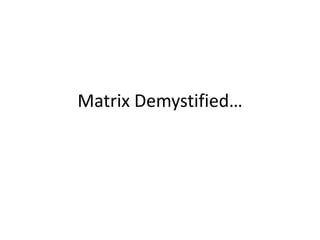
Matrix demystified
- 2. What is Matrix? • What is Matrix? – Novel, Movie?? – A Physical/Visual Construct? • (like grid…, or students in prayer hall) – Some geometric construct? (like rectangle, square??) – CS Data Structure (like Two Dimensional Array??) – Rows….Columns….Other definitions? ... – Yes, these are all fine, but why do we need this? • Addition, Subtraction – Oh, ok…. now, I see • Multiplication – Hey ---- What the heck is this !!! • Determinant, Inverse ---- ?$%# • Rank, Eigen-Value, Eigen-Vector----------Bhaago!!
- 3. Why this kolaveri di? • Root Cause – No Surprise, Our education system – Which divorces the description of mathematical ideas from their historical context – Not convinced? • Google for Matrix Multiplication • http://en.wikipedia.org/wiki/Matrix_multiplication#General_definition • Do you still want to study matrices? • Wrong Sequence – First Matrix, then addition/subtraction then multiplication – THIS IS WRONG – First Matrix Multiplication, then add/subtract, then Matrix – THIS IS RIGHT • This presentation is an attempt towards correcting this injustice done to simple and great idea of MATRIX
- 4. What is Matrix Multiplication? • Software Engineer – (for for for c[I,j] += a[I,k] * b[k,r] ) – One more successful program he wrote without understanding a, b, c (or m, n, r) of it • DSP Engineer - – Convolution, Weighted Sum, FIR, Pipelining… – Impressive terms , but why matrix? • Mathematician – See Wikipedia… • Super Market Clerk -??? –What is he doing here? – In all probabilities, he was the one who invented matrix multiplication and hence matrix!!!
- 5. Super Market – Birth Place of Matrix Multiplication • Let me explain… – Suppose you buy 1 kg Sugar, ½ Liter Milk and 5 cakes of detergent soap. – Let 1 Kg sugar = Rs. 61; 1 Liter Milk Rs. 40 and 1 cake of soap costs Rs. 25
- 6. Contd… • How will you calculate the cost? => 1 * 61+ 0.5 *1 + 5 * 1 = (….blank cheque ) => We can generalize it by applying famous [(price per unit) * (no units formula)] 1 [sugar price] + 40 [milk price] + 25 [ cake price ] That’s it!! Above expression is Matrix Multiplication This [Multiply and Accumulate] “*+” is central concept at matrix multiplication and hence at matrix
- 7. Contd… • This operation reduces it’s two sequences to a single number, or two vector operands to a scalar quantity • Let us see how…. – Split the above formula into two parts – Price Per Unit (PPU) List = [61 40 25] – Number Of Units = [1 ½ 5] • If you want to calculate the bill, you will multiply corresponding vectors, and add all the terms of resulting vectors( here, we can consider the term vector to mean lists)
- 8. Contd.. Total price = + ( [61 40 25] .* [1 ½ 5] ) = + ( [61*1 40*1/2 25*5] ) = + ([61 20 125]) = 206 Note two operations here 1. Multiplication between corresponding elements of two vectors of same size ( no of units * units price operation). One thing it converts different infos like kg, liter and 5 pieces to same unit price. This allows addition to be possible 2. Addition of all elements belonging to same vector
- 9. Contd… • These two operations together is called Matrix Multiplications + ([61 40 25] .* [1 ½ 5]) [61 40 25] * [1 ½ 5] ; //note that .* becomes just * now This itself represented as [1 ½ 5] * 61 40 25
- 10. This visual concept gives birth to idea of • A vector in horizontal orientation and another in vertical. • But it is just visualization. They could have been elliptical and diagonal also. • But, again why this circus? Why we could not keep both horizontal. • Answer is…
- 11. I too do not know • However, some guesses • To differentiate .* from * (not convincing enough) • To keep in-line with addition, and subtraction - Operands of +, - , .* are of same type - Result will also be of same type - But matrix multiplication yields scalar when two vectors are multiplied. Probably, notation helps to emphasize this fact that this is not straight multiplication
- 12. Contd… • Let us explore further. Let us consider 5 people shopped in the shop on a particular day. Using the notation discussed earlier 1½5 61 213 457 40 983 324 25 19 16.5 25 Note that row elements are of different types (sugar milk and soap) where as column elements are of same type. Keeping the same philosophy , since prices are of same type they better represented as columns. Note that adding a given column appears natural. For example, if you observe sum row below, it shows total amount of sugar sold in a day. Same is with Milik and Soap. However, adding all row elements of a row does not make any sense. What is Sugar + Milk + Soap? Sweet Washing System?.....Yucc!!! If we want to preserve this convention, price also should be column rather than row.
- 13. Contd… • Now, conventional matrix emerges, with rows columns etc., • I will leave it to you to extend to other matrix related ideas. (Ab tumhare havaale matrix saathiyon ) • All the best!!
